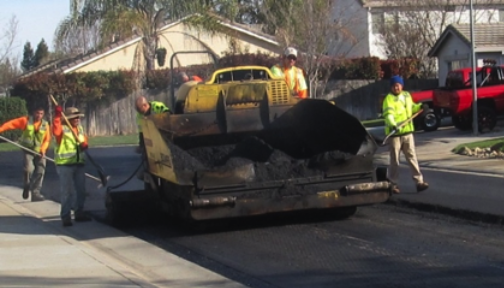Experience the Distinction: Hot Mix Asphalt Paving for Regrading Projects
Experience the Distinction: Hot Mix Asphalt Paving for Regrading Projects
Blog Article
Opening the Tricks of Warm Mix Asphalt Technology
Exploring the depths of hot mix asphalt innovation discovers a globe where careful procedures and exact formulas merge to form our roadways and facilities. The fusion of fillers, binders, and aggregates isn't merely a building task yet a critical orchestration of durability and efficiency. As we peer right into the detailed dancing of elements, a tapestry of resilience and sustainability unfolds. What lies below this surface area of asphaltic proficiency, and what secrets wait to be unveiled in the world of leading developments?
Value of Warm Mix Asphalt
Hot Mix Asphalt plays a vital duty in modern facilities advancement due to its longevity and cost-effectiveness. As the most commonly used leading product for roads, highways, and auto parking whole lots, Warm Mix Asphalt offers an array of benefits that contribute to its significance in building projects.
The durability of Warm Mix Asphalt stems from its structure, which includes accumulations, binder, and filler materials that are carefully picked and mixed to fulfill certain performance needs. Generally, the importance of Warm Mix Asphalt in facilities development can not be downplayed, as it continues to be a keystone of modern building and construction methods.
Components of Asphalt Mixes
The composition of asphalt blends is composed of thoroughly selected accumulations, binder, and filler products that are important for accomplishing specific performance needs. Aggregates are the key component of asphalt blends, giving stamina and security. The binder, usually asphalt or asphalt concrete, holds the aggregates with each other and provides adaptability and sturdiness to the mix.
The mix and proportion of these elements play a significant function in figuring out the top quality and efficiency of the asphalt mix. Designers meticulously design the mix to meet particular demands, taking into consideration elements like website traffic quantity, environment problems, and sidewalk lifespan. Proper choice and harmonizing of accumulations, binder, and fillers are crucial for producing sturdy, resilient asphalt pavements.
Combining and Production Methods

As soon as the accumulations are selected, the binder, typically asphalt concrete, is contributed to bind the products with each other. The binder's high quality and amount significantly impact the mix's versatility, stamina, and resistance to ecological elements. Furthermore, fillers like hydrated lime or Portland cement may be incorporated to enhance particular characteristics of the asphalt mix, such as its workability or moisture resistance.
Throughout manufacturing, the accumulations and binder are heated up, normally in between 250-325 ° F(121-163 ° C ), to assist in mixing and guarantee proper coating of the accumulations. The blending procedure needs to be complete to accomplish a homogeneous mixture that promotes the wanted efficiency qualities of the asphalt. Various strategies, such as set mixing or drum mixing, are employed to attain premium and constant asphalt blends for building and construction jobs.
Factors Influencing Asphalt Efficiency
Elements influencing asphalt efficiency include a variety of variables that influence the toughness, longevity, and total high quality of asphalt sidewalks. One crucial factor is the top quality of products utilized in the asphalt mix. The type and resource of aggregates, the binder top quality, and the additives all play a substantial function in determining the performance of the asphalt sidewalk. The rank of accumulations is vital as it affects the mix's workability, resistance, and stability to rutting and splitting.

Ecological problems also affect asphalt performance. Temperature level variants, wetness infiltration, and website traffic lots can all impact the architectural integrity of the pavement. Layout considerations, such as sidewalk thickness and drain, are important in ensuring the long-lasting efficiency of the asphalt pavement. By very carefully considering these designers, professionals and variables can maximize asphalt efficiency and boost the life span of sidewalks.
Lasting Practices in Asphalt Modern Technology

In addition, the growth of warm-mix asphalt (WMA) modern technologies has acquired traction over the last few years. WMA enables the production and placement of asphalt mixes at lower temperature levels contrasted to standard hot-mix asphalt, leading to minimized energy usage and greenhouse gas discharges. Moreover, making use of porous asphalt blends can assist reduce stormwater runoff issues by permitting water to infiltrate through the pavement and right into the ground, advertising natural water purification and charge processes. By implementing these lasting practices, the asphalt sector can contribute to constructing a more eco friendly and resilient infrastructure network.
Conclusion
Finally, hot mix asphalt innovation plays a crucial function in modern facilities growth because of its toughness and cost-effectiveness. By carefully stabilizing components, utilizing appropriate mixing techniques, and considering different aspects, engineers can produce high-quality asphalt blends that withstand rush hour lots and harsh weather conditions. Embracing lasting methods, such as utilizing warm-mix technologies and recycled materials, further enhances the environmental kindness of asphalt technology.
Mixing and manufacturing methods in go to my blog warm mix asphalt modern technology entail the precise combination and processing of aggregates, binder, and fillers to produce a high-performance and sturdy asphalt mix.Elements influencing asphalt efficiency encompass a range of variables that influence the durability, long life, and overall high quality of asphalt pavements. Sustainable methods in asphalt technology incorporate various initiatives aimed at decreasing the environmental influence of asphalt manufacturing and paving procedures. By including reclaimed asphalt sidewalk (RAP) and recycled asphalt tiles (RAS) into new asphalt blends, the sector can substantially reduce the usage of raw products and power, while additionally lowering garbage dump waste.
WMA allows for the manufacturing and placement of asphalt blends at reduced temperature levels compared to standard hot-mix asphalt, resulting in decreased energy consumption and greenhouse gas discharges.
Report this page